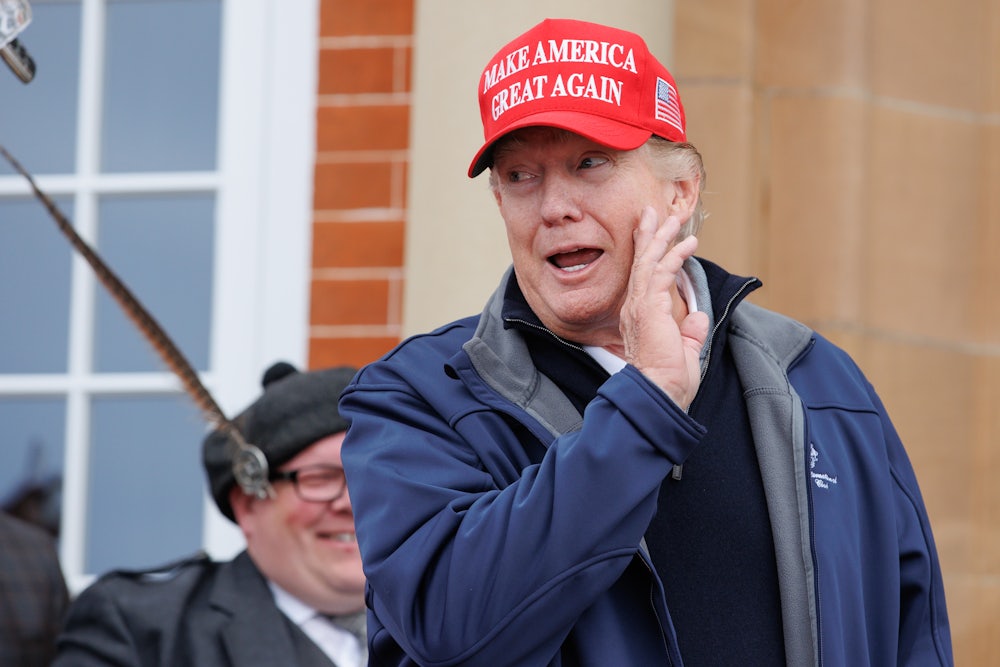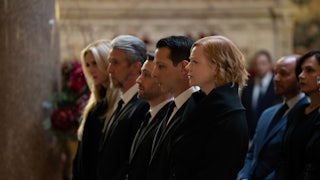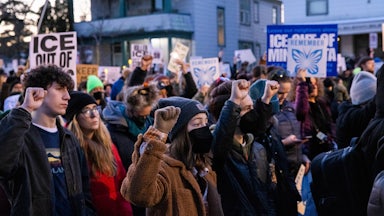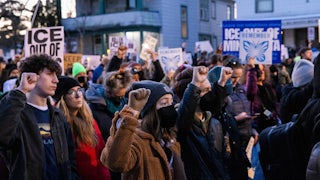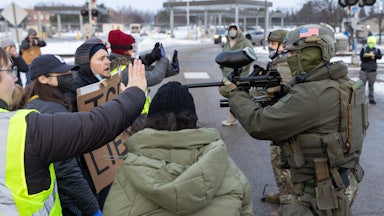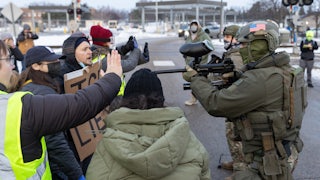The American public’s most recent chance to see Donald Trump at his worst came during that infamous CNN “town hall” meeting, during which Trump issued a steady, Gish gallop stream of lies. But largely lost in the stream of awfulness of that night were the foreign policy implications of a second Trump term, and how catastrophically disruptive and damaging they would be for global stability and U.S. national interests.
One of his biggest whoppers of the night was the repeated claim that he would end the war in Ukraine “within 24 hours,” without providing any details as to how. When moderator Kaitlan Collins pressed him about which side he supported in the war, he refused to support Ukraine. He instead deflected by saying, “I want everybody to stop dying.”
However, we know what his plan is. Trump represents an extreme view of the isolationist, pro-Russian school of foreign policy thought. If that were to become U.S. policy in 2024 (and it seems likely it will if he becomes president again), here’s what the world might look like.
Based on portions of an interview with Sean Hannity that were edited out, Trump’s plan is to cut off aid to Ukraine and pressure Ukraine into formally ceding Russian-speaking portions of the country to Vladimir Putin. These would most likely be Crimea, Donetsk, Luhansk, Zaporizhia, and parts of the Kherson Oblast. Trump would be giving Putin everything he wanted: These are exactly the areas that Russia claimed to have annexed during the fall of 2022 after holding a rigged referendum. Trump also regurgitated the Kremlin talking points about this war being about liberating oppressed Russian-speaking individuals from a tyrannical Zelenskiy government. (Worth noting: Volodomyr Zelenskiy is a native Russian speaker).
It’s no secret that Trump has always favored Russia, echoed its talking points, and had a soft spot for Putin. During the 2016 campaign, he denied that Russia had ever invaded Ukraine, despite the 2014 invasion of Crimea, Luhansk, and Donetsk. Then he rolled back sanctions on Russia and slow-rolled new sanctions after it became apparent Russia had interfered in the U.S. election. Worse, he sided with Putin and against U.S. intelligence and law enforcement agencies on the interference. He refused to divulge what he spoke with Putin about in Helsinki in 2018, keeping U.S. officials in the dark.
Trump’s foreign policy plans for his second term are even more despot-friendly than in his first. Multiple sources deep within the former regime, including chief of staff John Kelly, Secretary of Defense Mark Esper, and John Bolton have all confirmed that Trump intended to leave NATO. He also was ready to completely pull the United States out of South Korea. Esper was so dismayed by Trump’s recklessness that he reportedly hoped Biden would win the election. When confronted with these allegations, Trump’s spokesman did not deny them, instead claiming that those speaking out were warmongers and that Trump just wanted peace.
When all of these factors are taken together, it’s not hard to trace out how things are likely to go catastrophically wrong very quickly in a second Trump term. For the sake of analysis, let’s presume that he does exactly what he has indicated he will do: namely, cut off Ukraine from aid, pressure Zelenskiy to cede land, withdraw from NATO, and pull all U.S. forces from South Korea.
The U.S. provides the vast majority of the total aid to Ukraine. Without U.S. aid, victory for Ukraine likely becomes impossible, though it would almost certainly refuse to end the war on the terms Trump suggests. Instead, it would cast desperately about for more munitions from any source it could get and refuse to accept a humiliating set of ceasefire conditions. The war, as brutal as it is now, would likely drag out even longer than it would with U.S. support. An exhausted Russia lacks the means to push much further into Ukraine and would keep pressuring it to accept the deal offered by a Trump administration. Ukraine would lack the means to expel the invasion, but it would never accept such a humiliating, one-sided deal. If it were forced to it, the Ukrainian government could decide that the only way to secure a durable peace would be by developing its own nuclear weapons, without any security guarantees from the U.S. or NATO.
Without the U.S. in NATO, things could disintegrate quickly in Europe. Poland, the Baltics, Sweden, and Finland all feel they are in Russia’s crosshairs. With NATO shattered, Poland could decide that the only way to prevent Russia from finishing off Ukraine, rearming, and moving on to other neighboring countries to rebuild the “Ruskiy Mir” (Russian World, which broadly means all the former Soviet states and Eastern Europe as satellite nations) is to send its own forces to fight beside Ukraine.
Again, this is worse than the status quo where NATO forces are not directly involved in the war. It would likely lead to Russia attacking Poland. Poland would also be incentivized to start its own nuclear weapons program, no longer having the conventional or nuclear protection of the U.S. under NATO.
It’s also hard to underestimate the absolute panic a U.S. abandonment of Ukraine and withdrawal from NATO would cause among the Baltic states (Estonia, Latvia, and Lithuania) and in Finland. These states are likely incapable of defending themselves against Russia without swift and decisive intervention by the U.S. and NATO. And Russia very much considers all of them to be part of the traditional “Russian World.”
Which brings up another terrifying possibility: What if Trump wins a second term, forces Ukraine to cede land to Russia for peace, but doesn’t leave NATO? This is less of an improvement than one might think. Suppose Russia invaded the Baltic states after a period of rearming and reorganizing, and the U.S. (along with Putin’s ally Hungary) voted down the Baltic states’ request for NATO to invoke Article 5, which holds that an attack on one NATO nation is an attack on all but which requires unanimous consent to put into force.
If Russia knew beforehand that Trump was sympathetic to its claims that the Baltics are traditionally Russian and would veto an Article 5 request, it could leave Europe less prepared for further Russian aggression than if the U.S. had already left NATO. NATO would be caught mostly unprepared by the U.S. acting as a “fifth column” within its ranks. Its member nations would be utterly unready to go it alone outside of the NATO structure.
The picture isn’t quite as bleak in the Pacific, but it is still bad. Without the U.S. as a guarantor of security, and with an increasingly belligerent China representing a foe too large to resist without a U.S. alliance, neighbors such as South Korea will be tempted to develop nuclear weapons. It could take its cues from Israel and North Korea, who have used the threat of nuclear war to ward off potential invasions or to gain leverage in negotiations. The sort of global withdrawal Trump wants may not result in new wars but will probably encourage nuclear proliferation.
Without the U.S. supporting its global allies, nations such as Russia, China, and North Korea will benefit in the same way Iran benefited from the U.S. pullback from the Gulf region after the withdrawal from Iraq in 2012, the abandonment of our Kurdish allies in 2019, and the unilateral Trump decision in 2020 to rapidly pull out of Afghanistan in 2021. Biden followed through on the agreement to do the last with disastrous results. This destabilization will encourage military aggression. Client states abandoned by the U.S. will likely seek autonomy and security through the only realistic means available: namely, nuclear proliferation. Nations betrayed by a Trump administration may even seek to work together to develop nuclear weapons covertly, in the same way that Pakistani nuclear scientist Abdul Qadeer Khan allegedly helped North Korea, Pakistan, and Iran’s nuclear programs.
Trump claims to want to prevent war, build up U.S. security, and “stop the killing.” However, when you trace out the most likely outcomes of his proposed policies, you find they would achieve the exact opposite: more war, more death, an internationally weakened United States, emboldened regional adversaries, and more nuclear weapons held by more countries. In some ways, nuclear proliferation among nations resembles the problem we have domestically with all these guns: The more countries that have them, the more chances there will be for a state that feels backed into a corner to use them.
